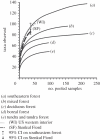Arctic plant diversity in the Early Eocene greenhouse
- PMID: 22072610
- PMCID: PMC3282332
- DOI: 10.1098/rspb.2011.1704
Arctic plant diversity in the Early Eocene greenhouse
Abstract
For the majority of the Early Caenozoic, a remarkable expanse of humid, mesothermal to temperate forests spread across Northern Polar regions that now contain specialized plant and animal communities adapted to life in extreme environments. Little is known on the taxonomic diversity of Arctic floras during greenhouse periods of the Caenozoic. We show for the first time that plant richness in the globally warm Early Eocene (approx. 55-52 Myr) in the Canadian High Arctic (76° N) is comparable with that approximately 3500 km further south at mid-latitudes in the US western interior (44-47° N). Arctic Eocene pollen floras are most comparable in richness with today's forests in the southeastern United States, some 5000 km further south of the Arctic. Nearly half of the Eocene, Arctic plant taxa are endemic and the richness of pollen floras implies significant patchiness to the vegetation type and clear regional richness of angiosperms. The reduced latitudinal diversity gradient in Early Eocene North American plant species demonstrates that extreme photoperiod in the Arctic did not limit taxonomic diversity of plants.
Figures




Similar articles
-
The palaeobiology of high latitude birds from the early Eocene greenhouse of Ellesmere Island, Arctic Canada.Sci Rep. 2016 Feb 12;6:20912. doi: 10.1038/srep20912. Sci Rep. 2016. PMID: 26867798 Free PMC article.
-
Eocene plant diversity at Laguna del Hunco and Río Pichileufú, Patagonia, Argentina.Am Nat. 2005 Jun;165(6):634-50. doi: 10.1086/430055. Epub 2005 Apr 7. Am Nat. 2005. PMID: 15937744
-
The Latitudinal Distribution of Morphological Diversity among Holocene Angiosperm Pollen Grains from Eastern North America and the Neotropics.Integr Comp Biol. 2018 Dec 1;58(6):1170-1178. doi: 10.1093/icb/icy097. Integr Comp Biol. 2018. PMID: 30084976
-
Biodiversity, distributions and adaptations of Arctic species in the context of environmental change.Ambio. 2004 Nov;33(7):404-17. doi: 10.1579/0044-7447-33.7.404. Ambio. 2004. PMID: 15573569 Review.
-
South American palaeobotany and the origins of neotropical rainforests.Philos Trans R Soc Lond B Biol Sci. 2004 Oct 29;359(1450):1595-610. doi: 10.1098/rstb.2004.1531. Philos Trans R Soc Lond B Biol Sci. 2004. PMID: 15519975 Free PMC article. Review.
Cited by
-
Late Cenozoic onset of the latitudinal diversity gradient of North American mammals.Proc Natl Acad Sci U S A. 2016 Jun 28;113(26):7189-94. doi: 10.1073/pnas.1524750113. Epub 2016 Jun 13. Proc Natl Acad Sci U S A. 2016. PMID: 27298355 Free PMC article.
-
The palaeobiology of high latitude birds from the early Eocene greenhouse of Ellesmere Island, Arctic Canada.Sci Rep. 2016 Feb 12;6:20912. doi: 10.1038/srep20912. Sci Rep. 2016. PMID: 26867798 Free PMC article.
-
Biogeography of photoautotrophs in the high polar biome.Front Plant Sci. 2015 Sep 11;6:692. doi: 10.3389/fpls.2015.00692. eCollection 2015. Front Plant Sci. 2015. PMID: 26442009 Free PMC article. Review.
-
A Phylogenomic Perspective on Evolution and Discordance in the Alpine-Arctic Plant Clade Micranthes (Saxifragaceae).Front Plant Sci. 2020 Feb 7;10:1773. doi: 10.3389/fpls.2019.01773. eCollection 2019. Front Plant Sci. 2020. PMID: 32117341 Free PMC article.
-
Early cenozoic differentiation of polar marine faunas.PLoS One. 2013;8(1):e54139. doi: 10.1371/journal.pone.0054139. Epub 2013 Jan 16. PLoS One. 2013. PMID: 23342090 Free PMC article.
References
-
- Wolfe J. A. 1977. Paleogene floras from the Gulf of Alaska region. Geol. Surv. Prof. Pap. 997, 1–108
-
- Hickey L. J., West R. M., Dawson M. R., Choi D. K. 1983. Arctic terrestrial biota: paleomagnetic evidence of age disparity with mid-northern latitudes during the late Cretaceous and early Tertiary. Science 221, 1153–115610.1126/science.221.4616.1153 (doi:10.1126/science.221.4616.1153) - DOI - DOI - PubMed
-
- McIver E. E., Basinger J. F. 1999. Early Tertiary floral evolution in the Canadian high arctic. Ann. Missouri Bot. Gard. 86, 523–54510.2307/2666184 (doi:10.2307/2666184) - DOI - DOI
-
- Basinger J. F., Greenwood D. R., Sweda T. 1994. Early Tertiary vegetation of Arctic Canada and its relevance to palaeoclimatic interpretations. In Arctic plants and climates: 65 million years of change (ed. Boulter M. C.), pp. 175–198 Berlin, Germany: Springer
-
- Eldrett J. S., Greenwood D. R., Harding I. C., Huber M. 2009. Increased seasonality through the Eocene to Oligocene transition in northern high latitudes. Nature 459, 969–97310.1038/nature08069 (doi:10.1038/nature08069) - DOI - DOI - PubMed
Publication types
MeSH terms
LinkOut - more resources
Full Text Sources

